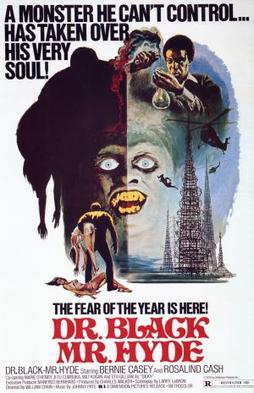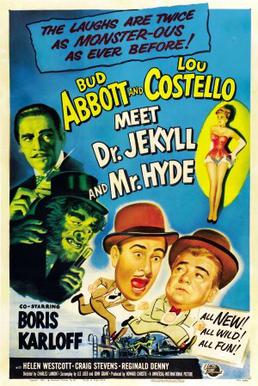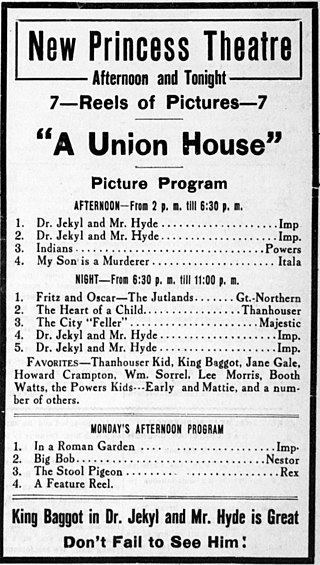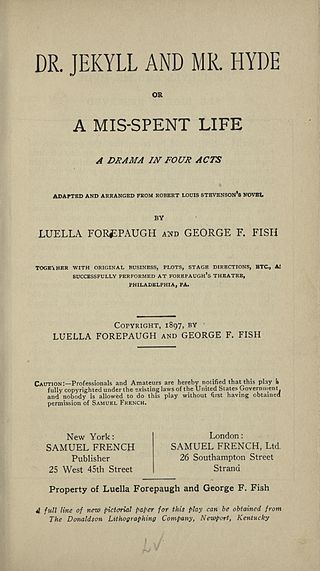
Dr. Jekyll and Mr. Hyde is a 1931 American pre-Code horror film, directed by Rouben Mamoulian and starring Fredric March, who plays a possessed doctor who tests his new formula that can unleash people's inner demons. The film is an adaptation of The Strange Case of Dr. Jekyll and Mr. Hyde, the 1886 Robert Louis Stevenson tale of a man who takes a potion which turns him from a mild-mannered man of science into a homicidal maniac.

Dr. Henry Jekyll and his alter ego, Mr. Edward Hyde, is the central character of Robert Louis Stevenson's 1886 novella Strange Case of Dr Jekyll and Mr Hyde. In the story, he is a good friend of main protagonist Gabriel John Utterson.

Dr. Jekyll and Mr. Hyde is a 1941 American horror film starring Spencer Tracy, Ingrid Bergman, and Lana Turner. The production also features Donald Crisp, Ian Hunter, Barton MacLane, C. Aubrey Smith, and Sara Allgood. Its storyline is based on the 1886 Gothic novella Strange Case of Dr Jekyll and Mr Hyde written by Scottish author Robert Louis Stevenson. There have been many filmed adaptations of the novella. This movie was a remake of the Oscar-winning 1931 version starring Fredric March.
Dr. Jekyll and Mr. Hyde, or Strange Case of Dr Jekyll and Mr Hyde, is a 1886 novella by Robert Louis Stevenson.

Dr. Jekyll and Mr. Hyde is a 1920 American silent horror film produced by Famous Players–Lasky and released through Paramount/Artcraft. The film, which stars John Barrymore, is an adaptation of the 1886 novella Strange Case of Dr Jekyll and Mr Hyde by Robert Louis Stevenson. John S. Robertson directed the production, and Clara Beranger wrote the screenplay, based on the 1887 stage play by Thomas Russell Sullivan that in turn was based on the novel.

Dr. Black, Mr. Hyde is a 1976 blaxploitation horror film loosely inspired by the 1886 novella Strange Case of Dr. Jekyll and Mr. Hyde by Robert Louis Stevenson. The film stars Bernie Casey and Rosalind Cash, and was directed by William Crain. Along with Crain, and it was written by Larry LeBron and Lawrence Woolner with cinematography by Tak Fujimoto. It was filmed primarily in Los Angeles, at locations such as the Watts Towers.

Abbott and Costello Meet Dr. Jekyll and Mr. Hyde is a 1953 American horror comedy film starring the comedy team of Abbott and Costello, co-starring Boris Karloff, and directed by Charles Lamont.

Dr. Jekyll y el Hombre Lobo, also known as Dr. Jekyll and the Werewolf, is a 1971 Spanish horror film, the sixth in a series of 12 films about the werewolf Count Waldemar Daninsky, played by Paul Naschy. Naschy actually plays a triple role in the film, portraying Waldemar Daninsky, the Wolf Man and Mr. Hyde. This was Naschy's 2nd film working with director Leon Klimovsky, following their hugely successful 1970 collaboration La Noche de Walpurgis. This film also featured Euro-Horror star Jack Taylor, Mirta Miller and the beautiful Shirley Corrigan of England. The film failed however to reach the box office success of Walpurgis.

Dr. Jekyll and Mr. Hyde is a 1912 horror film based on both Robert Louis Stevenson's novella Strange Case of Dr Jekyll and Mr Hyde (1886) and on the 1887 play version written by Thomas Russell Sullivan. Directed by Lucius Henderson, the film stars actor James Cruze in the dual role of Dr. Jekyll and Mr. Hyde, and co-starred his real life wife Marguerite Snow as well.

Dr. Jekyll and Mr. Hyde is a 1908 silent horror film starring Hobart Bosworth, and Betty Harte in her film debut. Directed by Otis Turner and produced by William N. Selig, this was the first film adaptation of Robert Louis Stevenson's 1886 novel Strange Case of Dr Jekyll and Mr Hyde. The screenplay was actually adapted by George F. Fish and Luella Forepaugh from their own 1897 four act stage play derived from the novel, causing a number of plot differences with the original source. Despite Stevenson's protests, this film became the model which influenced all the later film adaptations that were to come.

Dr. Jekyll and Mr. Hyde is a 1920 horror film directed and written by J. Charles Haydon, starring Sheldon Lewis, based on the 1886 novel Strange Case of Dr. Jekyll and Mr. Hyde by Robert Louis Stevenson. The Sheldon Lewis version was somewhat overshadowed by the 1920 Paramount Pictures version starring John Barrymore, which had been released just the month before.

Dr. Jekyll and Mr. Hyde is a 1913 horror film based on Robert Louis Stevenson's 1886 gothic novella Strange Case of Dr. Jekyll and Mr. Hyde. Directed by Herbert Brenon for producer Carl Laemmle's company IMP, the production stars King Baggot in the dual role of Jekyll and Hyde. The film was re-released in the United States in August 1927.

Dr. Jekyll and Ms. Hyde is a 1995 science fiction comedy film directed by David Price, based on Robert Louis Stevenson's 1886 horror novella Strange Case of Dr Jekyll and Mr Hyde. It stars Sean Young, Tim Daly, and Lysette Anthony. The story takes place in modern times and concerns a bumbling chemist who tampers with his great-grandfather's formula, accidentally transforming himself into a beautiful businesswoman who is determined to take over his life. This marked the second collaboration between Young and Daly after both previously starring in TV movie Witness to the Execution (1994).

Strange Case of Dr Jekyll and Mr Hyde is an 1886 novella written by the Scottish author Robert Louis Stevenson. It is about a London lawyer, Gabriel John Utterson, who investigates strange occurrences between his old friend, Dr. Henry Jekyll and the misanthropic Mr. Hyde. In a twist ending, it is revealed that Jekyll and Hyde were the same person, and that Jekyll had regularly transformed himself into Hyde by drinking a serum.

Docteur Jekyll et les femmes is a 1981 horror film directed by Walerian Borowczyk. The film is a variation on Robert Louis Stevenson's 1886 novella Strange Case of Dr Jekyll and Mr Hyde and stars Udo Kier, Marina Pierro, Patrick Magee, Howard Vernon, and Gérard Zalcberg.

Carl Alwin Heinrich Neuß was a German film director and actor, noted for playing Sherlock Holmes in a series of silent films during the 1910s. He also played the dual role of Jekyll and Hyde in the 1910 Danish silent film version of Dr. Jekyll and Mr. Hyde, directed by August Blom. He played Jekyll and Hyde again in the 1914 German silent film Ein Seltsamer Fall, scripted by Richard Oswald.

Strange Case of Dr Jekyll and Mr Hyde is an 1886 Gothic horror novella by Scottish author Robert Louis Stevenson. It follows Gabriel John Utterson, a London-based legal practitioner who investigates a series of strange occurrences between his old friend, Dr Henry Jekyll, and a murderous criminal named Edward Hyde.

Dr. Jekyll and Mr. Hyde, Or a Mis-Spent Life is a four-act play written in 1897 by Luella Forepaugh and George F. Fish. It is an adaptation of Strange Case of Dr Jekyll and Mr Hyde, an 1886 novella written by the Scottish author Robert Louis Stevenson. The story focuses on Henry Jekyll, a respected London doctor, and his involvement with Edward Hyde, a loathsome criminal. After Hyde murders a vicar, Jekyll's friends suspect he is helping the killer, but the truth is that Jekyll and Hyde are the same person. Jekyll has developed a potion that allows him to transform himself into Hyde and back again. When he runs out of the potion, he is trapped in his Hyde form and commits suicide.

Dr Jekyll and Mr Hyde is a British film adaptation of Robert Louis Stevenson's novella, directed by Maurice Phillips and starring John Hannah. Set in Victorian England, it was filmed in 2002 and released in Britain in that year. As the result of its release in the US in 2003, that date is sometimes attached to it.


















